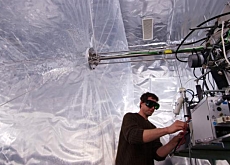lab airs dirty news

The atmospheric chemistry laboratory at the Paul Scherrer Institute (PSI) just outside Zurich is on the hunt for the exact causes of air pollution.
With its simulation facilities, mobile equipment and a measurement centre high in the Alps, the laboratory is an international leader in its field.
For the past few years, smog has been a regular topic in the media. Atmospheric pollution levels in Switzerland have exceeded legal limits for days on end all year round.
Recently PM10 fine particles have been in the spotlight. These particles are less than 10,000ths of a millimetre in diameter.
According to the Swiss Environment Agency PM10 particles can be responsible for respiratory distress, bronchitis and asthma attacks in children and adults, cardiovascular disease, lung cancer and even premature deaths.
Urs Baltensperger, head of the laboratory, says this highlights the need for more research. “We
desperately need to know which sources contribute to this pollution,” he told swissinfo. “So we are looking at just what these sources are.”
Baltensperger admits that health concerns are the driving force behind much of his research. Fine particle standards can be set only if the health effects of PM10 particles are known – but some questions remain unanswered.
Seeking answers
To find answers, Baltensperger’s team can draw on some of the best tools around: a smog chamber to simulate atmospheric conditions, a mobile measurement vehicle and a measuring station on top of the Jungfraujoch mountain ridge in the
Bernese Oberland.
The researchers are particularly interested in aerosols, particles often resulting from the burning of fossil fuels, as well as from natural sources such as vegetation.
Others are formed by secondary processes in the atmosphere under the influence of solar radiation and are known as secondary organic aerosols (SOA).
The measurement vehicle and the alpine recording station give the scientists plenty of data to crunch, but they needed another tool to explain the numbers. This is where the smog chamber comes in.
At PSI in Villigen, canton Aargau, Baltensperger’s team built the
chamber, which is not unlike a giant plastic bag, to study air composition. By pumping a mixture of gases into it, and with the help of powerful xenon lamps to mimic sunlight, they can simulate the composition on a given day.
Their results so far have explained why some aerosol levels were higher than earlier models had predicted.
International attention
Baltensperger says simulating conditions in Switzerland is not simple. Changes in terrain make it far more challenging and complex than the situation on the American plains.
But he adds that the results have
attracted international attention and given the Swiss an influential place in worldwide research.
“Our impact is important,” said Baltensperger. “Our smog chamber is also being used by foreign groups, from the United States, Britain and Germany for example.”
International collaborations with the best atmospheric specialists are important for the research too.
“Swiss funding alone would not suffice for our activities,” he admits. “European Union funding is needed to complete our financing and three of our projects are EU funded.”
Among those projects is one that goes beyond figuring out the
composition of the atmosphere.
Baltensperger is coordinating an EU project with medical specialists. They supply specially prepared lung cells to be exposed in the smog chamber to SOAs.
The immediate effects on the cells are then measured.
Baltensperger is in no doubt that this type of interdisciplinary science is the way forward.
“This is the kind of research we need to do in the future, with atmospheric specialists working with medical teams to answer health concerns,” he said.
swissinfo, Scott Capper in Villigen
The Paul Scherrer Institute is a research centre for natural sciences and technology.
In collaboration with universities, other research institutes and industry, PSI is active in solid state physics, materials sciences, elementary particle physics, life sciences, nuclear and non-nuclear energy research, and energy-related ecology.
It is the largest national research institute with about 1,200 members of staff, and is the only one of its kind in Switzerland.
The atmospheric chemistry laboratory is part of PSI’s general energy department.
Research includes the investigation of processes determining the gas and aerosol composition in the polluted atmospheric layer, and the identification of their sources and sinks.
The laboratory is also studying the impact of air pollution in the Alps, including the biosphere.

In compliance with the JTI standards
More: SWI swissinfo.ch certified by the Journalism Trust Initiative
You can find an overview of ongoing debates with our journalists here . Please join us!
If you want to start a conversation about a topic raised in this article or want to report factual errors, email us at english@swissinfo.ch.